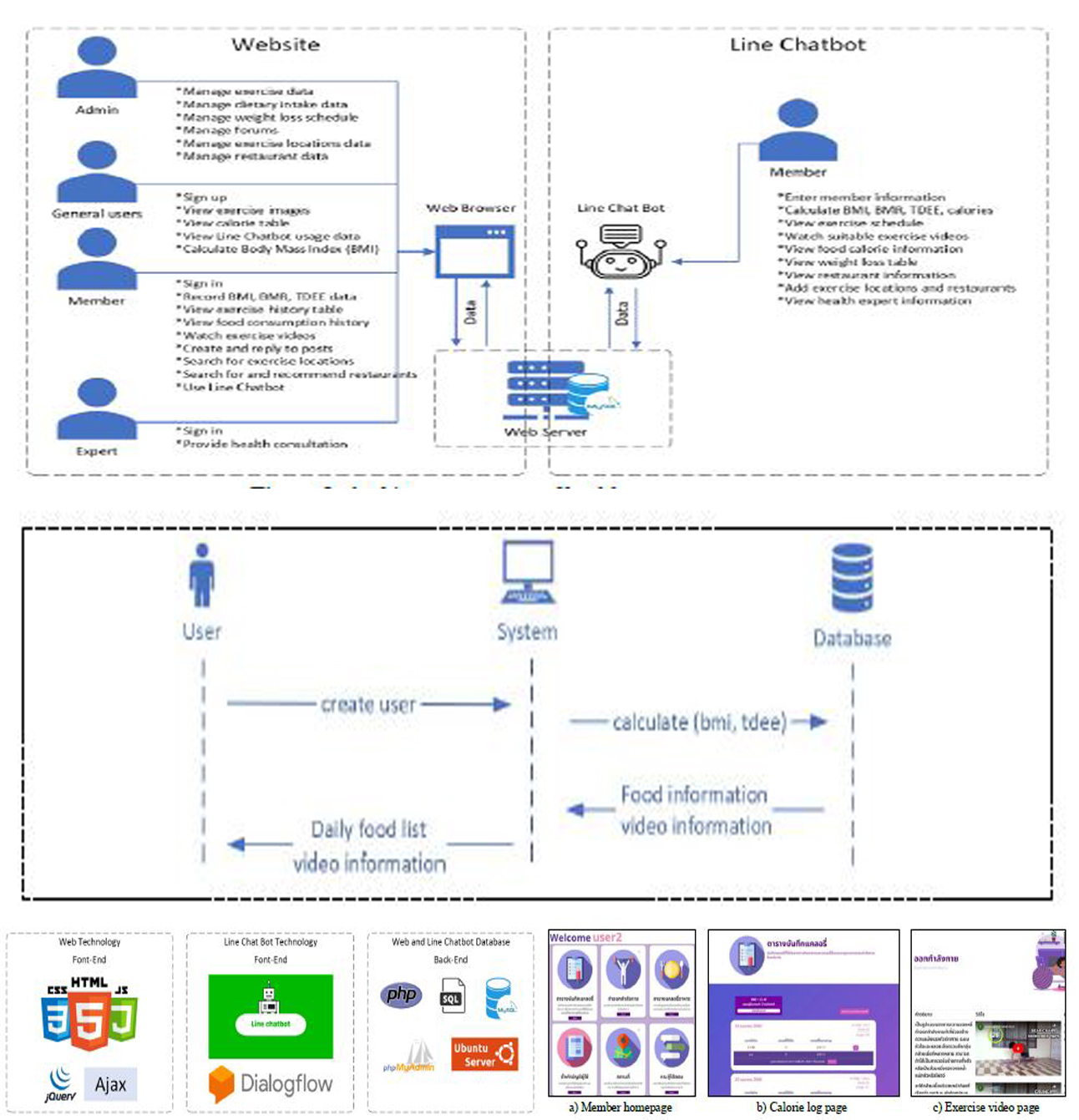Developing an Innovative Health Information Service System: The Potential of Chatbot Technology
DOI:
https://doi.org/10.53848/ssstj.v11i2.862Keywords:
Additional Refinements, Healthcare, Digital Health, Line Chatbot, Web DevelopmentAbstract
This study is a research and development with 3 main objectives: (1) to design and to develop a health management system; (2) to evaluate the efficiency and acceptability of technology; and (3) to compare the average Body Mass Index (BMI) before and after utilizing the developed health management system guided by the principle of the wellness plan. The study was divided into 3 phases: (1) study phase that conducts semi-structured interview with a group of students and healthcare professionals, along with literature review; (2) development phase that the health management system used an adapted waterfall model, dividing the system into two parts: website and Line Chatbot; and (3) experimentation and evaluation phase which the data were collected by using questionnaires that were used and analyzed by using descriptive statistics. This study found that the developed health management system was evaluated at a high level by 3 experts. Additionally, the system acceptability was evaluated at a high level by sample group of 33 individuals. The result of research showed that the developed system was able to be used as a tool for primary health management in the areas of diet planning and exercise including to the ability to track and analyze your own health.
References
Apache Friends. (2024). What is XAMPP. Retrieved from https://www.apachefriends.org/index.html
Assawamekin, N. (2015). Fundamentals of Software Engineering. Bangkok: SE-Education Public.
Bertram, D. (2007). Likert scales. Retrieved November, 2(10), 1-10.
Chengla, N., Prampate, C., & Ponsung, S. (2021). Development of Health Literacy Model of Overweight Students Using the Artificial Intelligence Activities and Social Network in Trang Province. Journal of Sakon Nakhon Hospital, 24(1), 11-22.
Canonical Ltd. (2024). Ubuntu Server documentation. Retrieved from https://ubuntu.com/server/docs
Department of Disease Control. (2021). Guidebook for Creating Health Knowledge in Disease Prevention and Health Hazard Control (978-616-11-4761-7). Department of Disease Control , Office of Risk Communication and Health Behavior Development.
Department of Disease Control. (2021). Know Your Numbers & Know Your Risks (978-616-11-4473-9). Department of Disease Control, ministry of public health. [in Thai]
Department of health. (2022). Wellness Plant. Bureau of Elderly Health, Department of Health, Ministry of Public Health. [in Thai]
Delone, W., & McLean, E. (2003). The DeLone and McLean Model of Information Systems Success: A Ten-Year Update. Journal of Management Information Systems, 19, 9-30.
Faculty of dentistry. (2019). Self-care manual for good health and happiness (978-616-407-421-7). Chulalongkorn University Press. [in Thai]
Google. (2024). Dialogflow. Retrieved from https://cloud.google.com/dialogflow/docs
Kimsungnoen, N., Setthawong, K., Boonya, P., Yantaporn, C., & Dechjob, N. (2023). Health Promoting Behaviors of Students at Rangsit University. APHEIT Journal of Nursing and Health, 5(2), 1-15.
Khamngoen, R., Phetrot, T., Jampairoh, N., Liamthong, P., Towangjorn, R., Paiklai, V., & Nuakalasin, S. (2023). The Effectiveness of the Health Behavior Change Program based on PBRI’s model and 7 Colors Ball Tool on knowledge and health behavior of Nursing Students with overweight. Journal of Health Research and Innovation, 6(2).
Lalam, P., Chaimai, A., & Fukfon, K. (2022). Metabolic syndrome in older persons: impacts and nursing roles. Journal of Nursing and Health Research, 23(2), 14-27.
Lamsal, K. (2020). Designing and Developing a dynamic website using PHP. Bachelor Degrees in Information Technology, Oulu University of Applied Sciences.
Naemi, R., Akbarian, M., Ebrahimi, M., Shahmoradi, L., Masoomian, B., & Rezayi, S. (2024). Design and evaluation of a web-based electronic health record for amblyopia. Frontiers in Medicine, 11. DOI : https://doi.org/10.3389/fmed.2024.1322821
Nelson, R. (2020). Health Informatics: An Interprofessional Approach. Elsevier Health Sciences.
Nyabuto, M. G. M., Mony, M. V., & Mbugua, S. (2023). Architectural Review of Client-Server Models. International Journal of Scientific Research & Engineering Trends, 10(1), 139-143.
Phokhwang, C., Sarakshetrin, A., Ngamwongwiwat, B., & Pramnoi, T. (2023). Attitude Toward Body Image, Nutrition and Exercise Knowledge for Weight Control, and Weight Control Behavior among Nursing Students from Two Educational Institutions: A Pilot Study. Vol. 9 No. 2, 58-73.
Phiwhlueng, A. (2024). The development of training course curriculum on classroom action research for strengthening the potential of teaching Thai language of teaching professional students. *Journal of Mani Chettha Ram Wat Chommani*, 7(1), 80-95.
Ruanphet, K., Khamanek, S., Ngomsangad, Y., Hiranwitchayakun, A., & Suwannawong, S. (2023). Factors Affecting Happiness among Students Attending Western University, Buriram Campus. REGIONAL HEALTH PROMOTION CENTER 9 JOURNAL, 17(3), 797–810.
Rmuti surin. (2022). Bachelor of Science Program in Computer Science.
Taptaemtut, M. (2023). A Health Literacy Lifestyle Program for Working Age People with Metabolic Syndrome, Lamae District, Chumphon Province. The Journal of Boromarjonani College of Nursing Suphanburi, 6(1), 145-159.
Ulrich, S., Gantenbein, A. R., Zuber, V., Von Wyl, A., Kowatsch, T., & Künzli, H. (2024). Development and Evaluation of a Smartphone-Based Chatbot Coach to Facilitate a Balanced Lifestyle in Individuals With Headaches (BalanceUP App): Randomized Controlled Trial. Journal of Medical Internet Research, 26. doi: 10.2196/50132
Wadeejaroen, W., Lertnaisat, R., & Teekasap, S. (2017). Research Methods: From Theoretical Concepts into Practice. se ed Publisher. [in Thai]

Downloads
Published
How to Cite
Issue
Section
License
Copyright (c) 2024 Suan Sunandha Rajabhat University

This work is licensed under a Creative Commons Attribution 4.0 International License.











